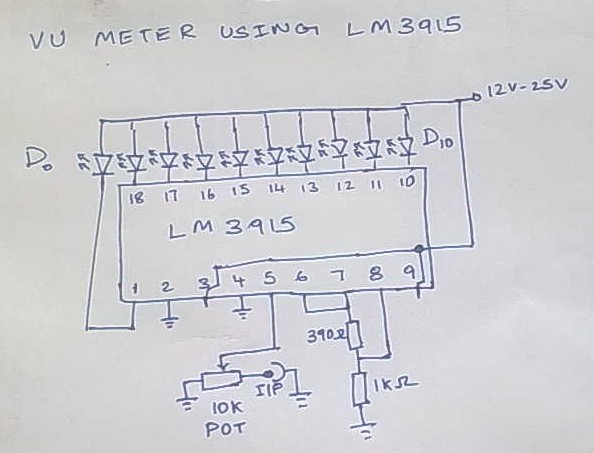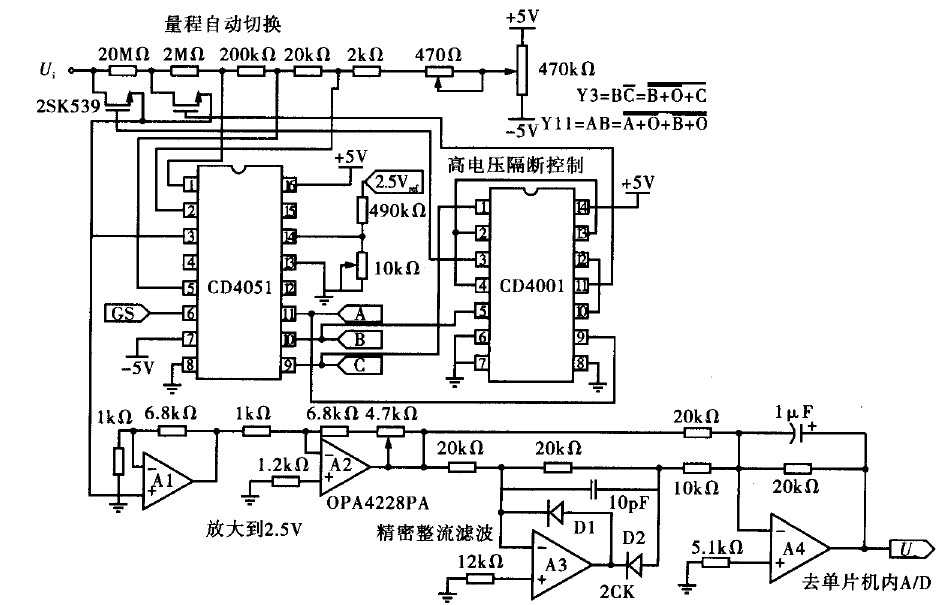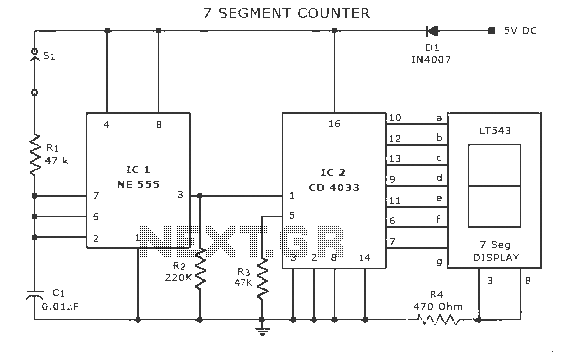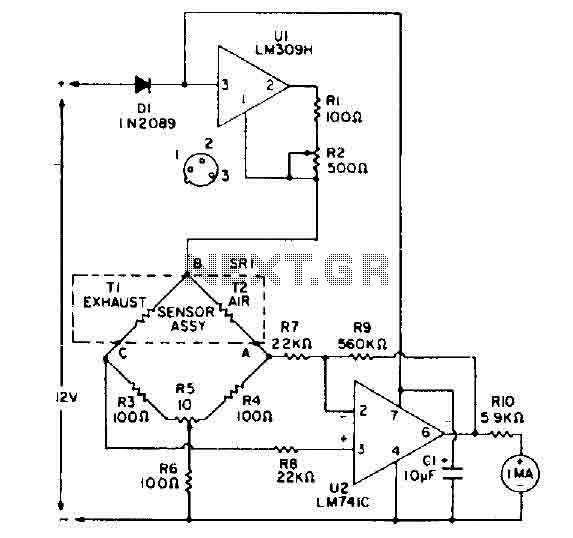
10 LED VU meter with LM3915
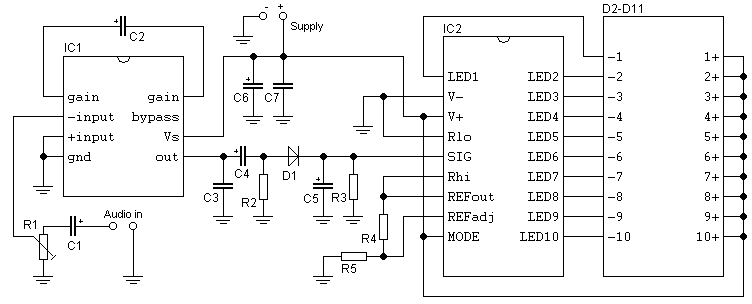
Supply voltage: 12 V. Supply current: 10 mA in stand-by, max. 80 mA. Input voltage: min. 20 mV rms. Indication range: 30 dB. LED currents: 7 mA. Ref. voltage of IC2: 5 V More: R1 - trimmer 100 k mini R2 - 2.2 k R3 - 1 M R4 - 2.7 k R5 - 6.8 k C1 - 0.47 uF C2 - 10 uF C3 - 47 nF C4 - 4.7 uF C5 - 0.1 uF C6 - 100 uF C7 - 100 nF IC1 - LM386 IC2 - LM3915 D1 - 1N4148 D2-D11 - bargraph or LED's
The circuit described operates with a supply voltage of 12 V, drawing a standby current of 10 mA, which can increase to a maximum of 80 mA during active operation. It is designed to accept an input voltage with a minimum of 20 mV RMS and has an indication range of 30 dB. The circuit utilizes an LED output with a current of 7 mA, driven by the reference voltage of 5 V provided by IC2, which is an LM3915 LED bar graph driver.
The resistive components include a trimmer potentiometer (R1) rated at 100 kΩ, which allows for fine-tuning of the circuit's gain or other parameters, alongside fixed resistors R2 (2.2 kΩ), R3 (1 MΩ), R4 (2.7 kΩ), and R5 (6.8 kΩ). These resistors are strategically placed to set the gain and biasing conditions for the operational amplifier IC1 (LM386), which is configured to amplify the input signal.
Capacitors in the circuit include C1 (0.47 µF), C2 (10 µF), C3 (47 nF), C4 (4.7 µF), C5 (0.1 µF), C6 (100 µF), and C7 (100 nF). These capacitors serve various functions, such as filtering, coupling, and decoupling, to ensure stable operation and prevent oscillations in the circuit. For instance, C2 may be used for power supply decoupling, while C1 could be part of an input coupling arrangement to block DC offsets.
Diode D1 (1N4148) is included in the design, likely for protection against reverse polarity or signal clamping, while D2 to D11 represent a series of LEDs or a bargraph display driven by the output of the LM3915. This visual indication allows for real-time monitoring of the input signal level, providing a clear visual representation of the amplitude of the incoming signal.
Overall, the schematic integrates these components to create a versatile amplifier and indicator circuit suitable for various audio and signal processing applications. The careful selection of components ensures that the circuit operates efficiently within its specified parameters.Supply voltage: 12 V. Supply current: 10 mA in stand-by, max. 80 mA. Input voltage: min. 20 mV rms. Indication range: 30 dB. LED currents: 7 mA. Ref. voltage of IC2: 5 V R1 - trimmer 100 k mini R2 - 2,2 k R3 - 1 M R4 - 2,7 k R5 - 6,8 k C1 - 0,47 uF C2 - 10 uF C3 - 47 nF C4 - 4,7 uF C5 - 0,1 uF C6 - 100 uF C7 - 100 nF IC1 - LM386 IC2 - LM3915 D1 - 1N4148 D2-D11 - bargraph or LED's 🔗 External reference
The circuit described operates with a supply voltage of 12 V, drawing a standby current of 10 mA, which can increase to a maximum of 80 mA during active operation. It is designed to accept an input voltage with a minimum of 20 mV RMS and has an indication range of 30 dB. The circuit utilizes an LED output with a current of 7 mA, driven by the reference voltage of 5 V provided by IC2, which is an LM3915 LED bar graph driver.
The resistive components include a trimmer potentiometer (R1) rated at 100 kΩ, which allows for fine-tuning of the circuit's gain or other parameters, alongside fixed resistors R2 (2.2 kΩ), R3 (1 MΩ), R4 (2.7 kΩ), and R5 (6.8 kΩ). These resistors are strategically placed to set the gain and biasing conditions for the operational amplifier IC1 (LM386), which is configured to amplify the input signal.
Capacitors in the circuit include C1 (0.47 µF), C2 (10 µF), C3 (47 nF), C4 (4.7 µF), C5 (0.1 µF), C6 (100 µF), and C7 (100 nF). These capacitors serve various functions, such as filtering, coupling, and decoupling, to ensure stable operation and prevent oscillations in the circuit. For instance, C2 may be used for power supply decoupling, while C1 could be part of an input coupling arrangement to block DC offsets.
Diode D1 (1N4148) is included in the design, likely for protection against reverse polarity or signal clamping, while D2 to D11 represent a series of LEDs or a bargraph display driven by the output of the LM3915. This visual indication allows for real-time monitoring of the input signal level, providing a clear visual representation of the amplitude of the incoming signal.
Overall, the schematic integrates these components to create a versatile amplifier and indicator circuit suitable for various audio and signal processing applications. The careful selection of components ensures that the circuit operates efficiently within its specified parameters.Supply voltage: 12 V. Supply current: 10 mA in stand-by, max. 80 mA. Input voltage: min. 20 mV rms. Indication range: 30 dB. LED currents: 7 mA. Ref. voltage of IC2: 5 V R1 - trimmer 100 k mini R2 - 2,2 k R3 - 1 M R4 - 2,7 k R5 - 6,8 k C1 - 0,47 uF C2 - 10 uF C3 - 47 nF C4 - 4,7 uF C5 - 0,1 uF C6 - 100 uF C7 - 100 nF IC1 - LM386 IC2 - LM3915 D1 - 1N4148 D2-D11 - bargraph or LED's 🔗 External reference

